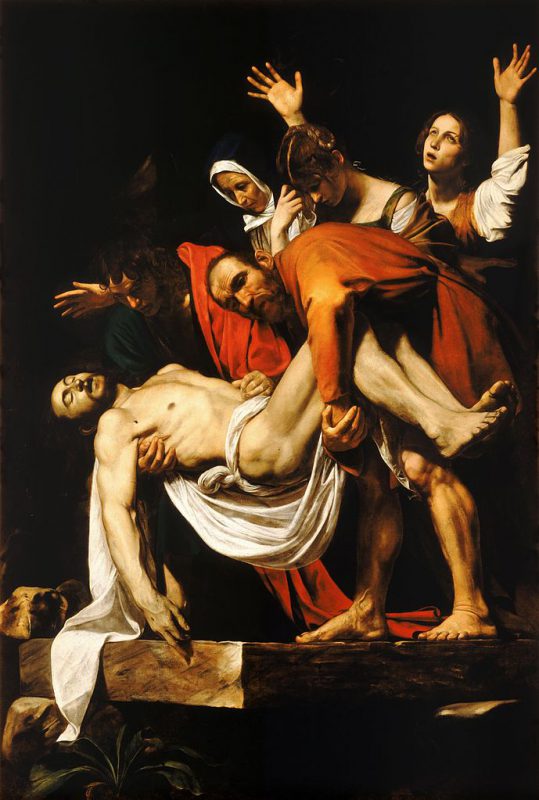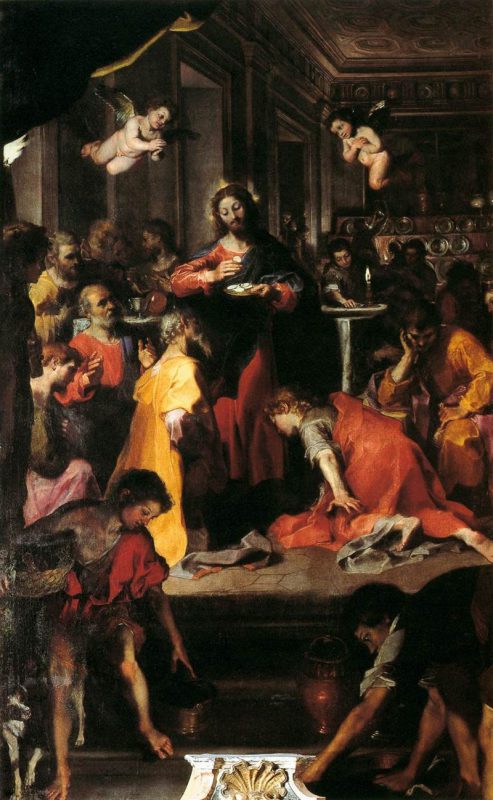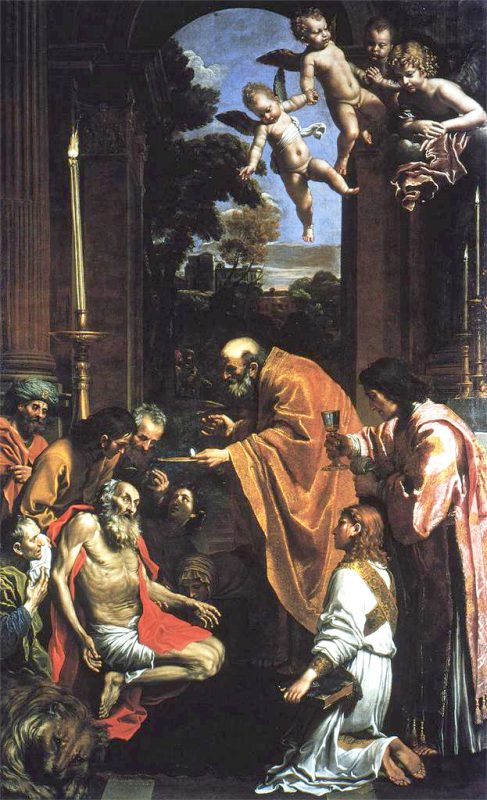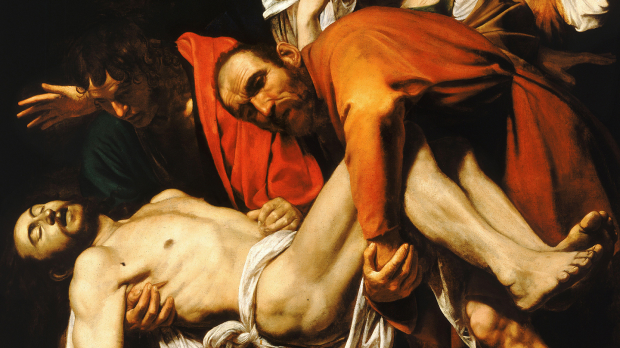Lenten Campaign 2025
This content is free of charge, as are all our articles.
Support us with a donation that is tax-deductible and enable us to continue to reach millions of readers.
On the 500th anniversary of the Protestant Reformation, this series of articles looks at how the Church responded to this turbulent age by finding an artistic voice to proclaim Truth through Beauty. Each column visits a Roman monument and looks at how the work of art was designed to confront a challenge raised by the Reformation with the soothing and persuasive voice of art.
The Counter-Reformation redesign of churches to focus the faithful on the Eucharist was only half the battle; one might lead the sinner to the bread of life, but how to convince him to believe? Yes, they could see the consecration, yes, they took communion more regularly, but how to open their spiritual eyes to the mystery of Real Presence?
Enter the painters. Brandishing brushes, flanked by theologians and girded with personal faith, artists worked to ignite the imagination and deepen adoration for the Eucharist in their empirical times.
Painters, grown expert in the Renaissance at rendering the natural world, were now required to illustrate mystery. Three painters rose to the occasion: Caravaggio, Barocci and Domenichino. Their works, spanning a decade, would blaze a Eucharistic trail through the Eternal City.
Caravaggio led the pack. Spotted by St. Philip Neri’s newly formed congregation of the Oratorians, the troubled yet brilliant artist was commissioned in 1603 by Pietro Vittrice for an altar in the newly renovated church of Santa Maria in Vallicella. Though clearly influenced by Michelangelo’s Pietà, his Entombment proposed the Real Presence in a strikingly updated way. Caravaggio’s version arranged six figures in a triangular mound against a dark background. The accusations by his peers of “excessive naturalism” appear justified looking at the aged Mary, Mother of God, the stocky Nicodemus and the dirty feet of Christ. Those, however, are the only naturalistic elements in the work – the figures are piled up without plausible spatial depth and the light has no natural source.

Against this darkness, supernatural light draws immediate attention to the gesticulating female figure at the apex of the composition. Her extended hand leads the eye downward, a rarity in art; where compositions usually pull the gaze upwards, Caravaggio composes towards the base of the canvas, where lies the altar – following the figures, the viewer is almost invited to physically bow.
The tumble of figures culminates in Christ, suspended above a stone slab, mirroring the altar below. His ungainly, lifeless body hangs heavily in midair, over a shadowy opening. Caravaggio’s world considered completing a composition one of the most important parts of artistry; leaving a gaping space would have immediately surprised the contemporary viewer, until the priest, celebrating the Mass at the altar, completed the picture. Building on Michelangelo’s Pietà where the body of Jesus seems about to fall from Mary’s lap to the altar, Caravaggio added an urgency to participate in the sacrament, this offering made for us.
Barocci was personally summoned in 1603 by Pope Clement VIII Aldobrandini to decorate his parents’ burial chapel in Santa Maria sopra Minerva with the Institution of the Eucharist. This pope, so committed to the Eucharist that he often wept at consecration, carried the monstrance barefoot during the Corpus Domini processions, and established the continuous Forty Hours adoration in Rome in 1592, took a hands-on approach with the artist and their letters demonstrate a deep concern with focusing the faithful on the Blessed Sacrament.

The new Counter-Reformation iconography left behind the moment of betrayal depicted in Renaissance Last Suppers and chose to illustrate the words of consecration uttered by the Jesus for the first time. Barocci was a great draftsman, able to compose with lines to stimulate the mind, but he was also a master of color who used a surprising mix of hues to create what he described as “complete music.”
The composition is formed out of three triangles, the acme of each at the head of Christ. The first extends down to the lower corners of the canvas where two young men are reaching towards the altar, as if to pick up the gifts presented there. The second triangle encompasses the kneeling saints Peter and John, to evoke the reverent prayers of consecration, now visible after the removal of the rood screens. Jesus’ arms form the final triangle, holding the host above the red part of His robe, a symbol of His humanity. Pope Clement repeatedly wrote the painter, insisting that he make Eucharist more evident. Barocci depicted a simple yet compelling “recipe” for the Eucharist – matter plus prayers equals the Body and Blood of Christ.
Rome owed the practice of the 40 hours’ devotion to St. Philip Neri who lived with confraternity of St Jerome of Charity for 33 years, before moving to Santa Maria in Vallicella. This confraternity devoted itself to burying the dead, ministering to prisoners, and celebrating eight masses a day. In 1612, Cardinal Pietro Aldobrandini, nephew to the Eucharist-loving Clement VIII, commissioned the Bolognese painter Domenico Zampieri to paint the Last Communion of St Jerome for the high altar of the church.

St. Jerome, dying, is accompanied by an eclectic band comprising (among others), a woman, a turbaned man, and a figure recalling a Roman aristocrat. A youth with the long hair distinctive to the confraternity members lifts the dying saint towards the host, as the grayed, folded limbs can no longer support him.
Rising above this sea of humanity stands the priest, holding the host moments after consecration. The deep bows of the priest, the deacon and subdeacon evoke the solemn dignity of the Lord’s presence amid the chaotic suffering of life. Jerome’s eyes awaken as he gazes upon the host, the shining passage to eternity, represented by the floating angels coming to claim his soul.
Although Domenichino was unjustly accused of plagiarism in the work by a jealous rival, what made the painting unique was its emphasis and focus on the Eucharist.
This Trail of Truth once led from the Pantheon to St Peter’s, but today Domenichino’s and Caravaggio’s works are both found in the Vatican Museums. They are well preserved, but away from their original altars, they are less able to express their true purpose of illustrating mystery.

